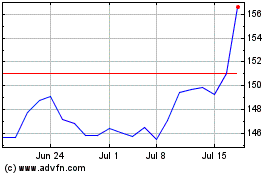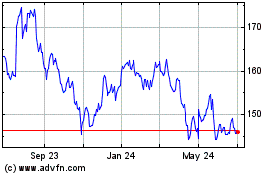By Andrea Riquier and Clive McKeef
Dow down 3.1% so far this quarter, wiping out the 1.2% gain last
quarter, but remains up 11.8% for the year
U.S. stocks continued their slide Wednesday and posted the worst
start to a quarter since 2008, with data showing slower job
creation adding to concerns about a weakening manufacturing sector
as President's Trump's trade policies take their toll.
Automobile manufacturers stocks fell after quarterly sales
reports from Ford and General Motors added to concern over profit
margins in the industry. All 11 S&P 500 sectors were down with
industries sensitive to economic growth dropping most. The last
time all 11 sectors fell for two straight days was December 24,
2018.
What did major stock indexes do?
Late afternoon the Dow Jones Industrial Average fell 494.42
points, or 1.86%, to 26,078 while the S&P 500 index lost 52.64
points or 1.79% to 2,887.61. The Nasdaq fell 123.44 points, or
1.56%, to 7,785.25.
The Dow and S&P 500 are now both below their 100-day moving
averages.
On Tuesday, the Dow lost 344 points, or 1.3%, to finish
26,573.04, the S&P 500 fell 37 points, or 1.2%, to end at
2,940.25. The Nasdaq Composite Index retreated 91 points, or 1.1%,
to close at 7,908.68. The small-capitalization Russell 2000 index
saw a steeper drop, losing 1.9% to 1,493.43.
Read: Dow, S&P 500 on track for worst start to a quarter
since 2008 financial crisis as recession fears accelerate
(http://www.marketwatch.com/story/dow-sp-500-on-track-for-worst-start-to-a-quarter-since-2008-financial-crisis-as-recession-fears-accelerate-2019-10-02)
What's driving the stock market?
A private-sector employment report
(http://www.marketwatch.com/story/adp-says-135000-private-sector-jobs-created-in-september-as-hiring-continues-to-slow-2019-10-02)
from Automatic Data Processing showed that a modest 135,000 jobs
were created in September, and the average monthly job growth for
the past three months also fell to 145,000 from 214,000 for the
same time period last year.
The ADP payrolls report was published ahead of the more closely
followed U.S. Labor Department's nonfarm-payroll report due on
Friday
(http://www.marketwatch.com/story/another-poor-us-jobs-report-would-add-to-wall-street-gloom-heres-what-to-look-for-2019-10-02).
The Alanta Federal Reserve's GDPNow forecast
(https://www.frbatlanta.org/cqer/research/gdpnow)for U.S. economic
growth in the fourth quarter has fallen 1.8%.
Market participants are hoping the Federal Reserve will cut
interest rates again when it meets in October, but the Fed may be
reluctant to lower rates again after two cuts so far this year.
New York Fed President John Williams on Wednesday pushed back on
market fears of a looming recession
(http://www.marketwatch.com/story/feds-williams-downplaying-recession-fears-says-outlook-very-favorable-2019-10-02),
saying that the baseline economic forecast remains "a positive
one."
"Right now, the outlook is actually very favorable," Williams
said during a talk at the University of California, San Diego. He
said GDP growth is around 2% rate, with a "very strong" labor
market and inflation near a 2% rate.
In international trade news on Wednesday, the U.S. won World
Trade Organization backing for tariffs on EU goods
(http://www.marketwatch.com/story/us-wins-wto-backing-for-tariffs-on-eu-goods-in-airbus-case-2019-10-02)
in an Airbus case over what the Trump administration said was
illegal subsidies granted to Airbus. The Trump administration will
put tariffs on $7.5 billion of imports from the EU as a result, the
Wall Street Journal reported
(https://www.wsj.com/articles/u-s-can-levy-tariffs-on-eu-exports-over-airbus-wto-says-11570025040?mod=hp_lead_pos6).
Meanwhile, the U.S. and China are due to resume talks next week
on resolving the trade dispute between the world's two largest
economies.
"Supportive central banks, bearish sentiment and attractive
yield opportunities are supportive of stocks," Bank of America
Securities said in a note. But "trade tensions, global growth
concerns, geopolitical risks plus signs of (profit) margin
compression and further downward risk to (earnings) estimates are
likely to limit upside going forward," the bank said.
Read: Stocks just delivered a reminder about October's
reputation for volatility
(http://www.marketwatch.com/story/history-shows-october-is-the-stock-markets-most-volatile-month-2019-10-01)
Which stocks are in focus?
Ford (F) fell after the automaker reported third-quarter vehicle
sales fell 4.9%
(http://www.marketwatch.com/story/ford-third-quarter-vehicle-sales-fall-as-declines-in-suv-and-car-sales-offset-truck-sales-growth-2019-10-02)
from a year ago, while General Motors (GM) also fell after
reporting poor quarterly sales
(http://www.marketwatch.com/story/gm-stock-falls-nearly-4-after-companys-q3-sales-2019-10-02-1191122).
Boeing (BA) was lower after a report
(http://www.marketwatch.com/story/boeing-shares-slide-13-on-report-engineer-filed-ethics-complaint-about-737-max-safety-issues-2019-10-02)said
an engineer filed an internal ethics complaint over the company's
decision to reject a safety system for the 737 Max on cost grounds
that he believed could have reduced risks tied to two fatal
crashes.
Discount-broker stocks continued to fall after the Tuesday
announcement by Charles Schwab Corp. (SCHW) that it would cut most
trading commissions to zero
(http://www.marketwatch.com/story/can-it-get-any-cheaper-to-be-an-investor-2019-10-01).
TD Ameritrade Holdings Corp. (AMTD) fell also.
Shares of pharmaceutical company Savara Inc.(SVRA) tumbled 47%
in morning trading after the company said the U.S. Food and Drug
Administration had found its application for a new medication
insufficient.
Johnson & Johnson(JNJ) shares rose after the company cut a
deal to avoid an upcoming opioid litigation trial.
How did other markets trade?
U.S. Treasury yields fell sharply Wednesday
(http://www.marketwatch.com/story/treasury-yields-tick-lower-as-investors-gear-up-for-us-private-sector-jobs-data-2019-10-02)
after growing worries about the health of the American economy drew
investors into government bonds at the expense of stocks. The yield
on the 10-year U.S. Treasury note was down about 6 basis points to
1.59% on Wednesday.
Gold prices settled back above the key $1,500 mark on Wednesday
(http://www.marketwatch.com/story/gold-edges-higher-as-traders-watch-for-us-private-sector-employment-data-2019-10-02),
after private-sector employment showed that the pace of hiring in
the U.S. is slowing, reviving worries about a recession in the U.S.
economy and spurring the purchase of assets perceived as havens.
Gold for December delivery jumped $18.90, or 1.3%, to reach
$1,507.90 an ounce, after rising 1.1% on Tuesday.
Oil futures declined Wednesday, with U.S. prices set for their
lowest finish in almost two months, as downbeat economic data
weighed on prospects for energy demand, and domestic crude
stockpiles registered a third straight weekly climb. West Texas
Intermediate crude-oil for November delivery was down 96 cents,
about 1.8%, to $52.66 a barrel on the New York Mercantile
Exchange.
In Asia overnight Wednesday, Chinese equity benchmarks were
closed in observance of the 70th anniversary of Communist rule.
Japan's Nikkei 225 meanwhile, fell 0.5%, wiping out a similar loss
from Monday. European stocks traded lower, with the Stoxx Europe
600 down 1.6%.
(END) Dow Jones Newswires
October 02, 2019 16:29 ET (20:29 GMT)
Copyright (c) 2019 Dow Jones & Company, Inc.
Johnson and Johnson (NYSE:JNJ)
Historical Stock Chart
From Mar 2024 to Apr 2024

Johnson and Johnson (NYSE:JNJ)
Historical Stock Chart
From Apr 2023 to Apr 2024
